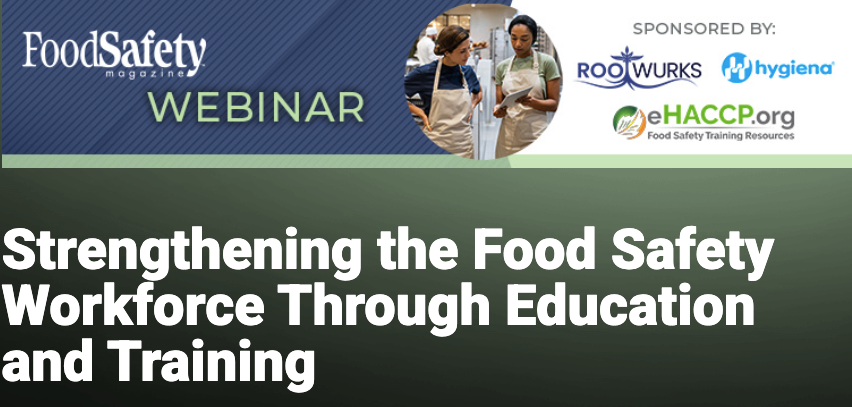Author: Ben Hartman | September 17, 2025 | 5 Min Read
How Can Companies Enhance Food Safety Education and Training? Here’s What the Experts Said

Food safety requires a skilled workforce, training that creates informed and inspired professionals, and the full commitment of leadership, according to the panelists on a Food Safety Magazine webinar last week.
In the webinar “Strengthening the Food Safety Workforce Through Education and Training,” panelists Clint Stevenson of North Carolina State University and Bertrand Emond of Campden BRI discussed the workforce shortages and challenges affecting food safety, and how coordinated education and training can make a significant difference.
Here are some key takeaways from the discussion.
We don’t have enough trained food safety workers
As supply chains become more complex, there is an ever greater need for safety training and protocols to safeguard the food supply.
But according to Stevenson, an associate professor in the Department of Food, Bioprocessing, and Nutrition Sciences at North Carolina State University and a former quality control and quality assurance professional at companies like Nestle, Kraft, and Heinz, there is a glaring shortage of trained food safety workers.
“We have a bottleneck of auditors, and as we transition over to the food and beverage companies that make the products, we see the lack of an abundant and qualified workforce, especially in the small and medium-sized companies.”
Stevenson said that the turnover rate in the food safety industry is between 12% to 25% and the vacancy rate is 10% to 15%, and that “as we think about the amount of expertise it takes to work in regulation, it’s going to take forever to build that workforce.”
Stevenson presented a slideshow that asserted that “workforce gaps in food safety directly jeopardize public health and consumer trust through inadequate oversight,” and argued that we should be working to “create a sustained pipeline of inspired professionals,” through an integrated curriculum that helps high school students explore the food safety field and make connections with employers.
He also said that within the food industry, companies should focus on apprenticeships and mentorships to accelerate skill development and learning retention among employees.
The whole elephant problem
Stevenson also spoke about the “whole elephant problem,” and how the food safety workforce develops a fragmented approach to food safety, much like the parable of the blind men and the elephant. He described how food safety is segmented between academia, the industry, regulators, and credentialing bodies - with no one segment getting a full picture of the issue.
“With shared standards, curriculum, policies, and informed job roles, we can have a comprehensive strategy so that now we understand what we’re touching when we’re touching elephants, and we’re working together,” Stevenson said.
He added, “by stepping back to see the whole elephant, we can build a comprehensive strategy that is far more effective than fragmented efforts”
He also called for the adoption of “rigorous, competency-based assessments in food safety training and education” because the lack of a formal licensing system can make it hard to stay on top of food safety.
Recognition and professional development are key
Stevenson listed three issues that get in the way of learning retention in food safety training: burnout from heavy workloads, compensation concerns regarding time spent in on-the-job training, and limited career advancement pathways.
“We have all of these challenges like burnout from heavy workloads and employees who are concerned about their compensation, and may be confused about what their various [career] advancement pathways are.”
He argued that “the more we do to recognize and provide professional development opportunities, it will promote retention in our workforce once we've recruited and developed people.”
Four fundamentals of food safety training
Bertrand Emond, an ambassador and former head of membership and training for Campden BRI, said that the point of food safety and workplace training is to ensure that “people do the right thing at all times, even when under pressure and when no one is watching.”
Emond said that success in food safety training relies on four fundamentals:
- Employees need to be competent
- Employees need to be confident and empowered
- Employees must be given the equipment and tools to be successful
- Employees need to be motivated for success in training
“People need to be empowered and feel empowered and confident to do the right thing right. They also need the ability to do it, which means they have the time and also the equipment,” Emond said, adding that they need to be able to quickly learn new skills and apply them effectively.
Three keys to success
Emond said that food companies need to focus on three keys to success: continuing professional development (CPD), lifelong learning (LLL), and a growth mindset.
In a culture of learning, employees are always seeking out new knowledge and skills and are encouraged to embrace a “growth mindset” and share their learning with others.
He said that under the growth mindset, companies urge employees to “take responsibility for their own development and share their learning with others, adding that this creates “a shift in the mindset that leads to a more dynamic and successful organization."
He argued that a fixed mindset is one in which you want to avoid mistakes instead of learning from them. Instead, feedback and encouragement are needed. With feedback from peers, employees don’t stay complacent and work to improve their knowledge and best practices.
He argued that a key approach companies must take is to ditch the “check the box mentality” that looks at training as nothing more than a necessary burden that they rush through before getting back to the floor. Instead, they should focus on customized training and learning paths.
“What we noticed is that most companies go for the one-size-fits-all approach, and unfortunately, one size does not fit all. The reason why companies settle for this is that it's often the cheaper option, but it is definitely not the most cost-effective, so people need to come out of that,” Emond said.
Emond said that one of the reasons for food safety recalls is that people make the same mistakes over and over and don’t take the time to learn from these mistakes.
He mentioned how scheduling time for training is one of the biggest challenges companies and learners face, and this is why it’s important to have “the commitment from the leadership of the business to provide enough time to train and the resources to do it properly.”
A lack of leadership commitment and time constraints are two of the top training challenges listed in the recent Rootwurks report "The Biggest Training Challenges in the Food Manufacturing Industry.” Download your free copy here.
If you missed the live broadcast, you can still watch the Food Safety Magazine webinar on demand here.
Contributors

Ben Hartman
From HACCP certification to the basics of hygiene, our on-demand courseware has you covered.






.jpg?width=120&height=80&name=Baby%20(1).jpg)




